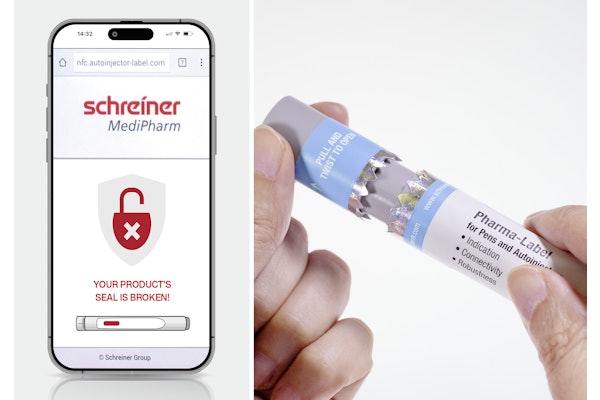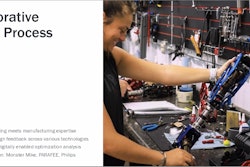Erlanger Medical Center in Chattanooga, TN, is taking steps to improve patient safety through bar-coded unit-dose packaging. To prepare drugs for bedside scanning, the hospital invested in an automated pharmacy packaging system from Swisslog.
The system is fully integrated and automated and consists of three modules: the PillPicker, which packages the drugs into unit doses; the DrugNest, which stores them until they are ready to be dispensed; and the PickRing, which dispenses drugs on a patient-specific ring in order of administration.
Bulk pharmaceuticals are transferred to a tamper-resistant plastic canister, called a PillBox, which is encoded with an RFID tag. These canisters are then loaded into the PillPicker, where the tamper-proof cover is removed. The robot removes each pill from the PillBox and places it in a unit-dose package, which is bar-coded and sealed. Packages are then transferred to the DrugNest and later dispensed via the PickRing.
Erlanger fills between 4,000 and 6,000 unit doses daily. The hospital's system also includes an optional module called AutoPhial that overwraps vials, ampoules, unit-dose cups, and syringes. Prior to investing in the system, the hospital's pharmacy relied on manual card fills, which required pharmacists to spend three hours filling each patient's medication for a 24-hour period. They also had to manually complete first-dose fills, which entail preparing the first dose of medication for a new patient. Pharmacy staff had to pull medication from the shelves, place it on trays, and double-check for accuracy. The trays were then transported to the patient floors, where nurses sorted and administered the drugs. With the new system, a 24-hour supply of medication can be assembled on a ring for each patient.
According to Jim Lowe, Erlanger's director of pharmacy, the PickRing presents the patient's medication in a better format: "It's easy to use, easy to read, and easy for nurses to find a patient's medication when they're on the floor," he says.
Ben Hinnen, business unit manager, Swisslog, describes the PickRing (shown) as a partner to bedside verification. "Nurses scan the patient's wristband, they scan their own wristband or badge, and then they scan the drug," he explains. "Once they open the package and administer the drug, the empty package remains on the ring, so the nurse has a visual indication of what's been given to the patient and what hasn't." Drugs can also be arranged in order of administration. A tag attached to the ring specifies each drug and administration time as well as other patient information.
Erlanger has also benefited from the system's ability to multitask. For example, the system has the ability to dispense medication out of either end, allowing it to perform card fills and first doses simultaneously. And while it's safe to say the robot has freed pharmacy staff up to perform other functions, the main goal of the system is to optimize patient safety. In the year and a half that Erlanger has been using the system, it appears to be doing just that.
--By Kassandra Kania
Kassandra Kania is a freelance writer based in Charlotte, NC. She has covered healthcare packaging for several years, most recently as a trade publication editor.
The system is fully integrated and automated and consists of three modules: the PillPicker, which packages the drugs into unit doses; the DrugNest, which stores them until they are ready to be dispensed; and the PickRing, which dispenses drugs on a patient-specific ring in order of administration.
Bulk pharmaceuticals are transferred to a tamper-resistant plastic canister, called a PillBox, which is encoded with an RFID tag. These canisters are then loaded into the PillPicker, where the tamper-proof cover is removed. The robot removes each pill from the PillBox and places it in a unit-dose package, which is bar-coded and sealed. Packages are then transferred to the DrugNest and later dispensed via the PickRing.
Erlanger fills between 4,000 and 6,000 unit doses daily. The hospital's system also includes an optional module called AutoPhial that overwraps vials, ampoules, unit-dose cups, and syringes. Prior to investing in the system, the hospital's pharmacy relied on manual card fills, which required pharmacists to spend three hours filling each patient's medication for a 24-hour period. They also had to manually complete first-dose fills, which entail preparing the first dose of medication for a new patient. Pharmacy staff had to pull medication from the shelves, place it on trays, and double-check for accuracy. The trays were then transported to the patient floors, where nurses sorted and administered the drugs. With the new system, a 24-hour supply of medication can be assembled on a ring for each patient.
According to Jim Lowe, Erlanger's director of pharmacy, the PickRing presents the patient's medication in a better format: "It's easy to use, easy to read, and easy for nurses to find a patient's medication when they're on the floor," he says.
Ben Hinnen, business unit manager, Swisslog, describes the PickRing (shown) as a partner to bedside verification. "Nurses scan the patient's wristband, they scan their own wristband or badge, and then they scan the drug," he explains. "Once they open the package and administer the drug, the empty package remains on the ring, so the nurse has a visual indication of what's been given to the patient and what hasn't." Drugs can also be arranged in order of administration. A tag attached to the ring specifies each drug and administration time as well as other patient information.
Erlanger has also benefited from the system's ability to multitask. For example, the system has the ability to dispense medication out of either end, allowing it to perform card fills and first doses simultaneously. And while it's safe to say the robot has freed pharmacy staff up to perform other functions, the main goal of the system is to optimize patient safety. In the year and a half that Erlanger has been using the system, it appears to be doing just that.
--By Kassandra Kania
Kassandra Kania is a freelance writer based in Charlotte, NC. She has covered healthcare packaging for several years, most recently as a trade publication editor.



















